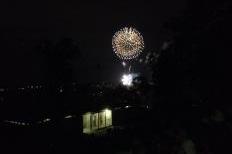






 Many people enjoy Rhythm and Booms, but federal law prevents Madison Metro from providing special service after the event (Photo by Marsha Rummel)
Many people enjoy Rhythm and Booms, but federal law prevents Madison Metro from providing special service after the event (Photo by Marsha Rummel)
--The Bus Stops Here is produced monthly by members of the Madison Area Bus Advocates
After 21 years, Rhythm & Booms was moved this summer from Warner Park to downtown Madison amidst controversy regarding both its old and new locations. Held June 28 (the last Saturday in June) to celebrate Independence Day, many functions officially opened at 2 p.m. while the fireworks over Lake Monona started at 9:30 p.m. and ended around 10:00 p.m.
A major concern was traffic although viewing the fireworks could involve going somewhere other than the official event grounds on John Nolen Drive between Blair St. and North Shore Drive. Event organizer Madison Festivals Inc. anticipated the needs of travellers and noted that, in addition to Madison’s 7,500 public parking stalls downtown, there were an additional 8,500 parking stalls easily accessed from the Beltline at Dane County’s Alliant Energy Center. It made using that lot reasonable by organizing a shuttle to/from it and downtown that ran continually between 2 p.m. and 11 p.m. And it tried to encourage visitors to take advantage of this special set up.
A smart move, the transportation situation could be made even better if someone could underwrite the cost of extending Metro service a little later than its current Saturday ending time of 11 p.m. Similar to the situation well-known to bar patrons everywhere, celebrations often include drinking; people who drive sober to an event may not be sober for the return trip. Providing shuttle service to a parking lot can deal with traffic and parking problems but cannot deal with the problem of drunk driving.
Drunk driving is a public safety issue that could be addressed by transit. Operators are not only sober but know how to avoid other potentially hazardous situations as well. Even inside the City in areas served by transit however, one could not just leave a car sitting overnight and take the bus home because the bus stopped running too early. Unless someone could walk, bike or get a ride from someone else after the show, those who had cars were forced to use them while transit-dependent people were simply out of luck.
Metro Transit used to offer special shuttle service to/from events such as Rhythm & Booms and football games. But in 2009, the Federal Transit Administration prohibited it. Calling its regulation the “charter rule,” it stipulated that any transit agency subsidized with federal money could not unfairly compete with privately-owned bus companies. Metro’s fares only cover part of the full cost of a ride while a private company’s fare must cover the entire cost.
After the ruling in 2009, the private bus company Kobussen Buses tried providing rides to/from Rhythm & Booms in place of Metro Transit but it no longer does. And although Kobussen provides shuttle service between several UW parking lots and the football stadium, no company ever tried to substitute for the special runs to athletic events that Metro Transit provided before. Metro Transit can put extra buses on some of its regular routes on football days to accommodate increased demand while still following the 2009 rule. It can also extend regular service after special events while following the rule. It does that on New Year’s Eve when it partners with Miller Lite, and could do something similar after Rhythm & Booms as well.
On New Year’s Eve, bus service is extended until 3:30 a.m. and involves fare-free rides. After Rhythm & Booms however, a reasonable extension could be much more limited (until 1:00 a.m.?) and would not need to be fare-free. The shuttle to the Alliant Energy Center was not fare-free.
By sponsoring a Metro Transit time extension, Miller Lite is providing a community service and receives good publicity from doing so. Rhythm & Booms also has sponsors oriented toward selling beer or insuring safety. Those sponsors could likewise benefit from providing the community service of extending Metro Transit’s service hours following Rhythm & Booms.
|
|
|
Welcome to the Madison Commons, a website designed to provide news and information about all of Madison's neighborhoods and a crossroads for the discussion of community issues. The name comes from the idea of a village commons, a place for news, talk, debate, and some entertainment, too, that's open to everyone.
All rights reserved. Read more about the Madison Commons and its partners.

